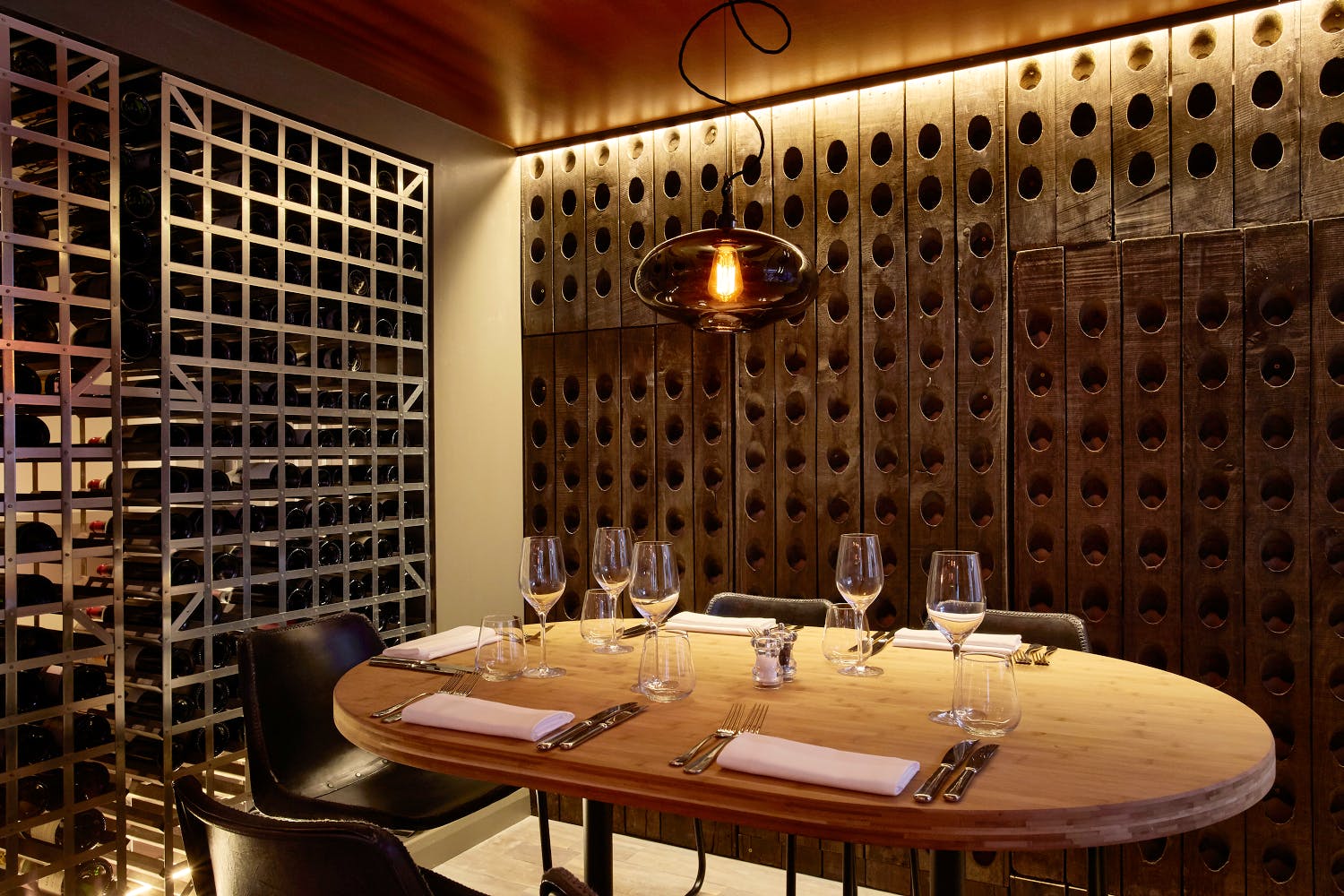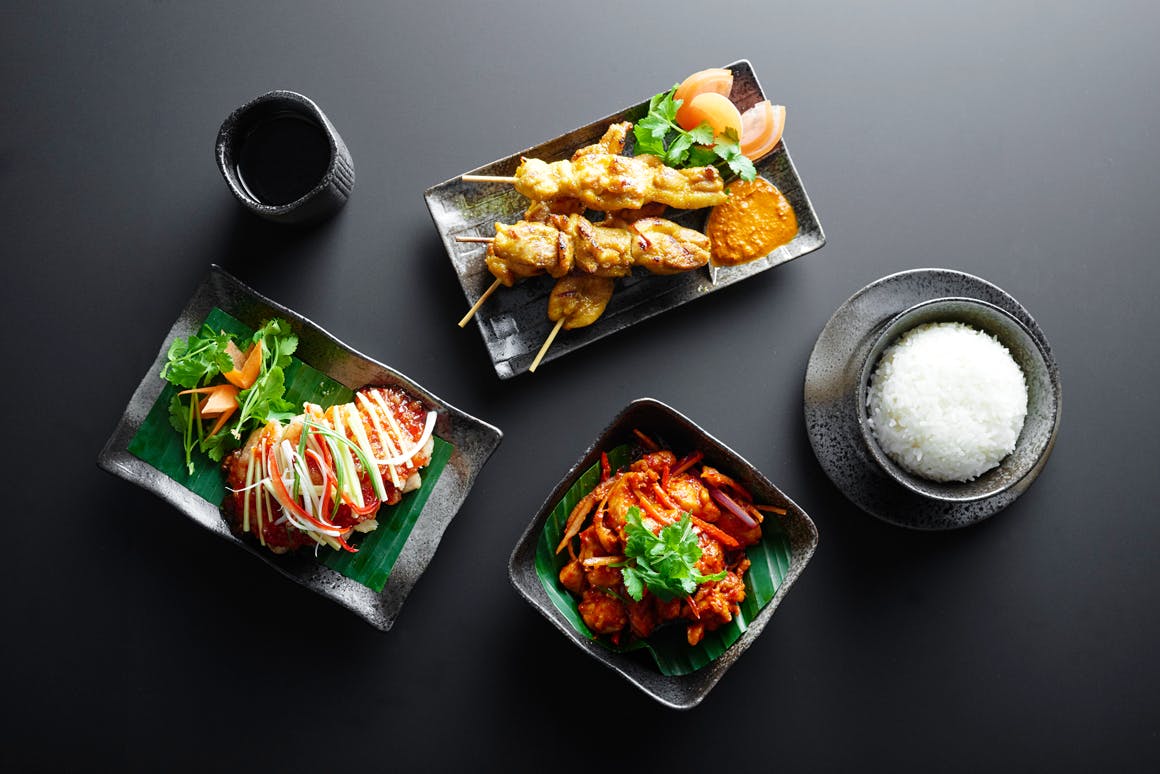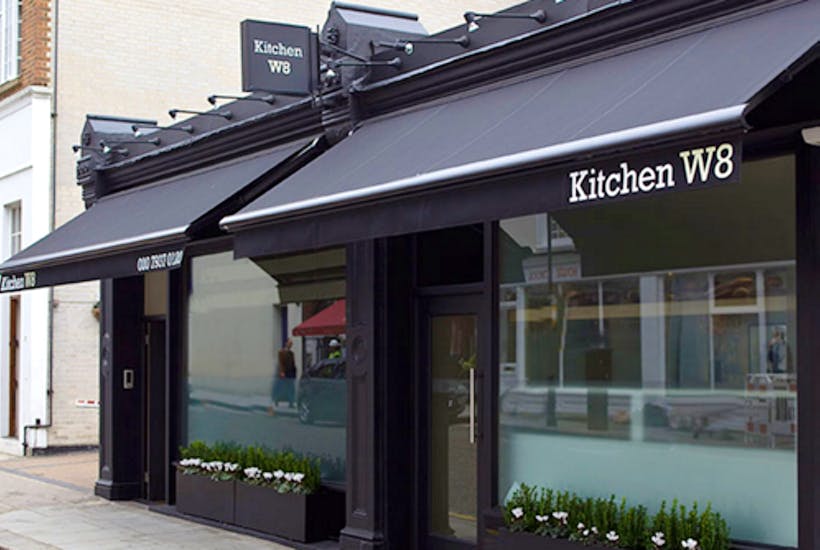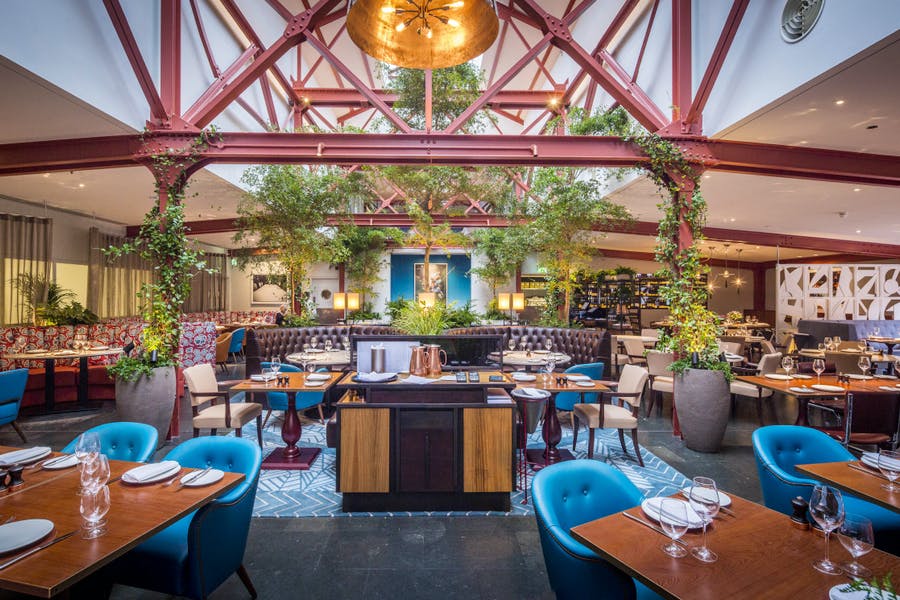Chelsea is a rarefied end of town. The old streets behind Cheyne Walk and around the Physic Garden are some of London’s most charming, while the King’s Road has for a long time been known as the place to be seen.
When it comes to restaurants, cheap eats are fewer and further between than other parts of London, but with hefty prices often comes quality. There’s a notable focus on organic produce and the countryside – possibly testament to Chelsea’s proximity to the M4 headed west. A few of the UK’s best known chefs have set up shop in the area and Chelsea is home to some of the city’s prettiest eateries. As ever, the following list of recommendations is just for starters…
Café culture

A Daylesford lunch is served (Instagram)
Bluebird
Bluebird was once an art deco garage owned by 1920s racing legend Sir Malcolm Campbell. His vehicles were called ‘Bluebird’. Today the stink of fuel has been replaced by the aroma of wonderful food. It’s both for ladies-who-lunch and those looking for a late night bite, with a courtyard café rustling up breakfast from 8am and a shiny corrugated steel bar serving drinks until 1am at the weekends. The menu offers clean and smart takes on classics: roasted duck breast, vegetable en croute and the like.
Daylesford Farm Shop
At the end of a run of wallet-bruising interiors shops is Daylesford’s Chelsea outpost. Daylesford started life as an organic farm in the Cotswolds and is now a series of cafés (the others are in Marylebone and Notting Hill), a cookery school and the farm itself. The farmhouse breakfast and daily quiche (both £14) are worth a try, as is the delicious scrambled eggs.
The Good Life Eatery
Right in the heart of Chelsea (not a few minutes walk from the Saatchi Gallery), the airy Good Life Eatery is something of a millennial cliché – but a good one nonetheless. Avocados and quinoa litter the menu and while the ‘Lean Machine’ bowl might sound a little too ‘gym-goer’ for some, it actually features some very good chicken meatballs.
Tanya’s
Don’t be put off that the main courses are described as ‘living’ at this ever-so-wholesome raw food café inside the MyChelsea hotel. The eponymous Tanya is a holistic coach and wellness evangelist who liaised with the MyChelsea owners to set up what it says is London’s first eatery with a fully raw and organic menu. Not one for the carnivores, in other words. The ‘living’ mains include dishes such as a mushroom, walnut and almond ricotta lasagne and a pad thai made with kelp noodles. All as virtuous as the fern-adorned glass house it is set in.
Well-designed

Private dining at Bandol (barbandol.co.uk)
The Belvedere
Once the 17th century summer house of Holland House, The Belvedere is an idyllic spot for lunch after a stroll in the park. To jazz up the historic architecture, disco balls and Warhol prints have been installed but that doesn’t divert much from decorous dishes of grilled plaice or poussin. The Sunday lunch is good and on weekdays there is a du jour menu offering two courses for £17.95.
Parabola
No surprise that the Design Museum, reopened in 2017, has a good-looking restaurant with plate glass walls and minimalist place settings. By day it is very much everything you’d want a museum restaurant to be – sandwiches, salads, and a few heartier offerings such as lamb chops. By night the menu is designed by well-regarded chef Rowley Leigh. Suitably British fare given modern and seasonal twists.
World’s End Market
The World’s End Market was once the World’s End pub – a renowned and much-loved King’s Road boozer that had been around since the 1600s. Apart from parts of the bar, the place has had its decor removed and it’s been redone in the style of a swabbed down meat market – monochrome tiling and industrial lamps – with a menu to match. The list of dishes may seem basic (choose your meat, choose your side) but the result is very good – notably the ox.
Bandol
This attractive restaurant with exposed bulbs, a ‘living wall’ and shiny copper surfaces is more affordable than you might think (not cheap, nonetheless). Sharing plates of tiger prawns or black ink risotto come in ataround the £11-£13 mark. The house carpaccio the same. It is the Provencal-style sister restaurant of Margaux on Brompton Road – a place known for society clientele including Pippa Middleton (they say).
Kurobuta
Less refined design, more bold and fun, Kurobuta is based on the izakayabar-cum-restaurants that litter the streets of Tokyo. It was opened by ex-Nobu chef Scott Hallsworth, who knows a thing or two about Japanese small plate eating, and started Kurobuta as a pop-up at one end of King’s Road. The food is Japanese by way of America – sashimi pizza, wagyu sliders etc.
The Botanist
In many ways it doesn’t get too much more ‘Chelsea’ than The Botanist. Looking out over Sloane Square, the restaurant has recently been refurbished by Russell Sage in a style that pays homage to the botanist who gave his name to much of the neighbourhood: Sir Hans Sloane. Recommended for either a late night interlude or an elegant meal. Hot tip is the bass ceviche to start.
Swankier spots

try Medlar for seasonal British fare with a French twist (medlarrestaurant.co.uk)
Maze Grill Park Walk
Gordon Ramsay’s flagship restaurant can be found a stone’s throw from Chelsea Royal Hospital. The hushed tones are less from fear of the eponymous chef and more likely to be in awe of the food, which is as you’d expect from a three Michelin-starred establishment, is more theatrical and fascinating than filling. The à la carte menu, largely French in influence, offers three courses for £110 and waiters who are more than happy to talk diners through the details. The current chef de cuisine is Matt Abe – a Ramsay protégé.
Medlar
Seasonal British ingredients with a bit of French chic might be the best way to describe Medlar’s menu. The team behind it come from revered places such as The Ledbury and Chez Bruce in Wandsworth and the pedigree is evident. A rump of Belted Galloway arrives with gently cooked snails, while pork medallions come with oca de peru – an unusual South American plant. The buzz is quiet: a nice spot for an evening linger.
Launceston Place
Launceston Place was once the favourite eatery of Princess Diana. Since then it has undergone a number of incarnations, most recently with east London wunderkind Ben Murphy in charge of the kitchen. From the outside it looks like a smartened up pub but inside has the feel of a more Michelin-type establishment with a minimalist menu to match. People speak highly of the mushroom and parmesan dish – mostly with surprise that a fungus can be so tasty.
Elystan Street
In March 2016, chef Phil Howard gave up his two Michelin-starred restaurant The Square – where he had been for 25 years – and later that year opened Elystan Street. Less traditional, more hip – think denim-apron wearing waiters and pastel art deco inspired chairs – it is typical of Chelsea’s relaxed wealth. The food is equally good looking with a lively list of ingredients from Tokyo turnips to bacon and stout jam.
The Five Fields
Behind a typically Chelsea cottage-like facade, hides a favourite neighbourhood establishment. Clientele sport linen shirts and loafers and the decor is all in inoffensive neutral tones. You’ll need to book a table as it’s regularly full thanks to the food, which comes just the right side of adventurous. The tasting menu (which includes suckling pig) will set you back £90.
Something unusual

Malaysian food at Zheng (zhengchelsea.co.uk)
Flat Three
Not many restaurants are basing their entire menus around fermented goods. Flat Three – which has a slick Scandinavian interior and Far Eastern inspired food – is something of a pioneer in this respect offering a vegan and meat-based tasting menu. Accompanying it is an intriguing list of organic wines. The taste of umami kept me going for a while afterwards.
Villa Mama
It’s not every day you come across a Bahraini restaurant. The only other Villa Mama’s outpost is in Bahrain itself so recipes come direct from the motherland. It’s pretty: banquettes of faded cushions hug walls decked out with colourful Middle Eastern hangings. The menu takes a bit of deciphering but it’s worth the Googling to try Machbous Deyay (Bahraini chicken pilaf) and for brunch – which they started serving from December – the Balaleet (saffron vermicelli with scrambled egg). Don’t miss grabbing a piece of the chunky carrot cake as you leave.
Thali Restaurant
You can order a good rogan josh at Thali Restaurant but you can equally go off chart and try the snow crab or tandoori grouse. The vibe is elegant (white tablecloths and candlelight) and it has a lounge which is open for drinks and Indian nibbles. The dishes – they say – benefit from having been passed down through three generations of north Indian chefs. The signature thali is one to remember.
Chakra
Chakra is a ritzy Indian nearing the Notting Hill end of Chelsea & Kensington. The menu reflects the smart, urban set it serves with a few curveballs such as duck breast tikka, truffle kulcha and avocado and cumin pastries. Food is prettily served with flowers on slate, and the Brissi-style interior lends it a more dainty atmosphere than your average Indian. All the grub can still be washed down with a Cobra beer though.
Dinings SW3
This new offshoot from Dinings in Harcourt Street does, like its original branch, offer up Japanese ‘tapas’. Many people are loyal to the Harcourt Street branch but the SW3 restaurant is probably the comfier of the two. The ‘tapas’ is essentially a Japanese take on small plate dining. Sushi and sashimi play a large part but more interesting perhaps are the British-Japanese mash ups such as asparagus with yuzu hollandaise and the Japanese Wagyu mini-burgers.
Zheng
Zheng, born out of an original and slightly smaller Oxford venue, is – as you walk in – exactly what you expect a glammed up Asian restaurant to look like: black wood, orchids, sheeny velvet. The food (Malaysian) is hailed as some of the best of its nation’s cuisine in London – even if that sounds unlikely in Chelsea. The roast duck is universally recommended as is the coconut rice.
Chicama
Of all the Peruvian restaurants that opened when London fell in love with the South American country’s padron peppers and ceviche around 2016, Chicama may be the prettiest. It is the second restaurant from the team that opened Marylebone’s Pachamama and focuses on fish: John Dory, lemon sole, brill on occasion – the market selection changes daily. Save room for a pisco sour and one of the very good puddings.
Institutions

The bar at The Ivy Chelsea Garden (theivychelseagarden.com)
Bibendum
Bibendum is something of a legend on the London restaurant scene. It was first opened by Terence Conran and Paul Hamlyn in 1987. If you can, it’s worth visiting just for a drink to admire the building. Last year French chef Claude Bosi – a two Michelin star holder – took over the kitchen to great acclaim. Be prepared for a lot of offal: Bosi’s mother’s tripe is the signature dish.
The Cross Keys
Hard to believe from the inside but The Cross Keys is Chelsea’s oldest pub, open since 1708. Today it is more polished than it probably was when the artists JMW Turner or John Sargeant graced its bar. It runs a reliably good menu of refined pub classics all day such as scotch eggs and chicken liver parfait with port jelly. Alongside the very decent wine list this makes it a good place to escape from rainy afternoons.
The Ivy Chelsea Garden
An institution of sorts – if you count that this is the third instalment of Richard Caring’s expansion of one of London’s best known haunts: The Ivy in Covent Garden. This Ivy is set in an Edwardian house on the King’s Road, which as you might expect attracts a chattering crowd. The menu is almost terrifyingly huge but at least you aren’t stuck for choice and the posh nosh brasserie-type dishes do tend to be well cooked.
Il Trillo
This family-run Italian has been on the incongruously named Hollywood Road since 1983. With a sister restaurant in Tuscany, it can lay claim to being one of Chelsea’s most Italian Italians. The menu stays pleasingly true to the family roots as does the wine list. The pasta and focaccia is all homemade on the premises and the back garden is a magical place to spend a summer night.
Maggie Jones
Inside Maggie’s it feels more like a country cottage than a Chelsea restaurant. It is packed to the rafters (quite literally) with ploughing harnesses, wicker baskets and old church chairs and has been serving locals for 40 years. Food is good and old-fashioned – traditional doesn’t mean untasty here – and it’s a popular spot at lunch too. If you’re hungry get the fish pie and one of the enormous puddings.
Farm to fork

The place to go for Sunday lunch (kitchenw8.com)
Rabbit
Given Chelsea’s proximity to the Cotswolds by way of M4, it’s no surprise that places like Rabbit have set up in the borough – even if the Gladwin brothers who own Rabbit actually hail from west Sussex. Rabbit is their second restaurant after The Shed in Notting Hill and is meant to celebrate what they call ‘wild food’. The menu is smartened up salt-of-the-earth type fare: think venison cigars and baked root vegetable carpaccio. The Sunday lunch cuts come direct from the Gladwin’s farm.
Kitchen W8
Unusual perhaps for Michelin-starred place to be recommended for its Sunday lunch but so it is at Kitchen W8, another Phil Howard joint. The decor is more urban than farm but the menu has a run down of things like chestnut gnocchi, winter vegetable chutney, mallard legs and poached plums – all warming to countryside cockles. You can also bring your own wine if you like (£25 corkage, although there is no corkage on Sunday evenings).
Tom’s Kitchen
Tom Aiken’s Chelsea outpost is in the old Blenheim pub. It’s kept a smart meat market feel not unlike St John: clean white and wood. Sit up at the bar to watch the bartenders at work on cocktails with as high quality ingredients as the food. Aiken’s is hot on using British suppliers. Chicken comes from Devon, meat from the Lake District and the eggs (which are probably the menu highlight) come from Stow-on-the-Wold.
Ffiona’s
The fish and chips at Ffiona’s are said to be legendary but the restaurant does a good selection of other dishes too. All with a strongly British stamp. Ffiona has a daily blackboard of game and meat specials sourced from different regions of the UK – often Cornwall (for fish) and Wales (lamb) – cooked in a homely style. She also serves a plentiful brunch at the weekends (one option is an 8oz steak), Favoured by genteel neighbourhood types.






Comments